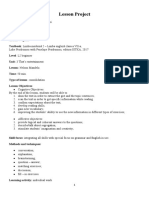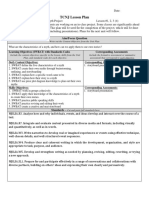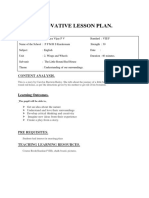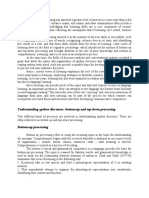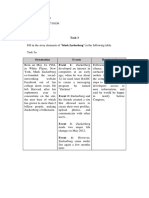0 ratings0% found this document useful (0 votes)
746 viewsDecriptive Text Definition of Descriptive Text
The document defines descriptive text as text that describes what a person, place, or thing is like in order to reveal characteristics. Descriptive text generally includes an identification section introducing the topic, a description section noting features, and serves the purposes of specifically describing a particular subject. Key language features of descriptive text are the use of specific examples, adjectives to clarify nouns, the simple present tense, and action verbs.
Uploaded by
Andromeda kenCopyright
© © All Rights Reserved
Available Formats
Download as DOCX, PDF, TXT or read online on Scribd
0 ratings0% found this document useful (0 votes)
746 viewsDecriptive Text Definition of Descriptive Text
The document defines descriptive text as text that describes what a person, place, or thing is like in order to reveal characteristics. Descriptive text generally includes an identification section introducing the topic, a description section noting features, and serves the purposes of specifically describing a particular subject. Key language features of descriptive text are the use of specific examples, adjectives to clarify nouns, the simple present tense, and action verbs.
Uploaded by
Andromeda kenCopyright
© © All Rights Reserved
Available Formats
Download as DOCX, PDF, TXT or read online on Scribd
You are on page 1/ 1
DECRIPTIVE TEXT
Definition of Descriptive Text
Descriptive Text is a text which says what a person or a thing is like. Its purpose is to
describe and reveal a particular person, place, or thing.
Generic Structure of Descriptive Text
When writing descriptive text, there are some generic structures (actually not mandatory) for
our writing to be true. The arrangement is:
a. Identification: (contains about the introduction of a person, place, animal or object will be
described.)
b. Description: contains a description of something such as animal, things, place or person by
decribing its features, forms, colors, or anything related to what the writer describe.
Purpose of Descriptive text
1. To describe person, thing or place in specific.
2. To describe a particular person, thing or place.
Language Feature of Descriptive Text
1. Specific participant : has a certain object, is not common and unique (only one). for example:
Bandengan beach, my house, Borobudur temple, uncle Jim
2. The use of the adjective (an adjective) to clarify the noun, for example: a beautiful beach, a
handsome man, the famous place in jepara, etc.
3. The use of simple present tense: The sentence pattern used is simple present because it
tells the fact of the object described.
4. Action verb: verbs that show an activity (for example, run, sleep, walk, cut etc….
You might also like
- Children Literature Evaluation Form Picture BookNo ratings yetChildren Literature Evaluation Form Picture Book5 pages
- Lesson Plan - Nelson Mandela (Consolidation)No ratings yetLesson Plan - Nelson Mandela (Consolidation)5 pages
- Ba Ca Da Fa Ga Ha Ja Ka La Ma Na Pa Ra Sa Ta Va Wa Ya Za100% (1)Ba Ca Da Fa Ga Ha Ja Ka La Ma Na Pa Ra Sa Ta Va Wa Ya Za27 pages
- English Grammar Micro Teaching Lesson Plan On Noun Illustration With ExampleNo ratings yetEnglish Grammar Micro Teaching Lesson Plan On Noun Illustration With Example2 pages
- Instructional Objectives: (THE PUPIL) : Teaching PointNo ratings yetInstructional Objectives: (THE PUPIL) : Teaching Point5 pages
- Year 5 Listening and Speaking Lesson PlanNo ratings yetYear 5 Listening and Speaking Lesson Plan5 pages
- LANGUAGE-ACROSS-CURRICULUM-ENTIRE NOTESNo ratings yetLANGUAGE-ACROSS-CURRICULUM-ENTIRE NOTES108 pages
- Clinton D. Zamora III - Semi Detailed LP Week 2No ratings yetClinton D. Zamora III - Semi Detailed LP Week 24 pages
- Reading Comprehension Is The Ability To Process Written TextNo ratings yetReading Comprehension Is The Ability To Process Written Text11 pages
- Analysis of Language Teaching MaterialsNo ratings yetAnalysis of Language Teaching Materials12 pages
- Research On ELT - Outline of The Research Proposal0% (1)Research On ELT - Outline of The Research Proposal5 pages
- English Model Lesson Plan For Class 1 To 5 Multi Grade TeachingNo ratings yetEnglish Model Lesson Plan For Class 1 To 5 Multi Grade Teaching23 pages
- FG Group Presentation Textual Metafunction and Theme System100% (1)FG Group Presentation Textual Metafunction and Theme System17 pages
- Meaning & Characteristic of Psycholinguistic100% (1)Meaning & Characteristic of Psycholinguistic3 pages
- Critical Journal Review (Sociolinguistic)No ratings yetCritical Journal Review (Sociolinguistic)6 pages
- Language Acquisition and Language Learning MaterialsNo ratings yetLanguage Acquisition and Language Learning Materials2 pages
- Innovative Lesson Plan.: Content AnalysisNo ratings yetInnovative Lesson Plan.: Content Analysis5 pages
- Word Structure and Word Formation ProcessesNo ratings yetWord Structure and Word Formation Processes7 pages
- The Interface Between Semantics and Pragmatics50% (2)The Interface Between Semantics and Pragmatics10 pages
- Understanding Spoken Discourse: Bottom-Up and Top-Down ProcessingNo ratings yetUnderstanding Spoken Discourse: Bottom-Up and Top-Down Processing5 pages
- Forest Conservation Is The Preservation and The Protection of ForestsNo ratings yetForest Conservation Is The Preservation and The Protection of Forests1 page
- Rein Lionel Reinhart Hariono - 6-9 Non-Fictional Reading Response 2021No ratings yetRein Lionel Reinhart Hariono - 6-9 Non-Fictional Reading Response 20218 pages
- Year 7 French Revision List - Final Exam-23-24No ratings yetYear 7 French Revision List - Final Exam-23-241 page
- Factors Affecting Foreign Language Learning and Teachin1No ratings yetFactors Affecting Foreign Language Learning and Teachin13 pages
- 2nd Grade Journey's Unit 1 Week1 Day 2 The Perfect PetNo ratings yet2nd Grade Journey's Unit 1 Week1 Day 2 The Perfect Pet49 pages
- Applied Linguistics LANE 423-DA-Updated PDFNo ratings yetApplied Linguistics LANE 423-DA-Updated PDF6 pages
- Interchange5thEd Level2 Language Summary Unit6 PDFNo ratings yetInterchange5thEd Level2 Language Summary Unit6 PDF1 page
- Instant Access to Holt Traditions Warriner s handbook second course grammar usage mechanics sentences Teacher s edition John E. Warriner ebook Full Chapters100% (5)Instant Access to Holt Traditions Warriner s handbook second course grammar usage mechanics sentences Teacher s edition John E. Warriner ebook Full Chapters72 pages
- Focus4 2E Grammar Quiz Unit5.5 GroupB 1kolNo ratings yetFocus4 2E Grammar Quiz Unit5.5 GroupB 1kol2 pages
- World of Self, Family and Friends UNIT 7 - Get Dressed! Listening 1 Monday Respect Others LanguageNo ratings yetWorld of Self, Family and Friends UNIT 7 - Get Dressed! Listening 1 Monday Respect Others Language2 pages
- Ibnulyemen Arabic Short Stories For Non-Natives: (Beginners)No ratings yetIbnulyemen Arabic Short Stories For Non-Natives: (Beginners)22 pages
- DAP AN KIỂM TRA GIỮA KÌ 2 - LỚP 9 -No ratings yetDAP AN KIỂM TRA GIỮA KÌ 2 - LỚP 9 -14 pages



